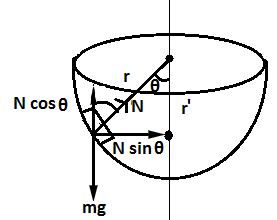
A hemispherical bowl of radius \[r\] is set rotating about its axis of symmetry in vertical. A small block kept in the bowl rotates with the bowl without slipping on its surface. If the surface of the bowl is smooth and the angle made by the radius through the block with the vertical is \[\theta \]. Then, find the angular speed at which the ball is rotating.
\[\begin{align}
& A)\omega =\sqrt{rg\sin \theta } \\
& B)\omega =\sqrt{\dfrac{g}{r\cos \theta }} \\
& C)\omega =\sqrt{\dfrac{gr}{\cos \theta }} \\
& D)\omega =\sqrt{\dfrac{gr}{\tan \theta }} \\
\end{align}\]
Answer
560.7k+ views
Hint: The block and bowl are rotating with the same angular velocity. Due to the rotation a centripetal force acts on them. Given that, the radius makes an angle with the vertical axis. Since the block is not slipping on the surface of the block, forces acting on the block are balanced. Here, we can equate the horizontal and vertical components of forces acting on the block. Using the equations for both vertical and horizontal components of forces, we can find the angular velocity of the block.
Formula used:
\[{{F}_{c}}=m{{\omega }^{2}}{{r}^{'}}\]
\[N=N\cos \theta +N\sin \theta \]
\[W=mg\]
Complete step by step answer:

The centripetal force that the rotation exerts on the block, \[{{F}_{c}}=m{{\omega }^{2}}{{r}^{'}}\]
Where,
\[m\] is the mass of the bowl
\[\omega \] is the angular velocity
\[{{r}^{'}}\] is the radius
Since, the block kept in the bowl rotates with the bowl, without slipping on its surface; the forces on the block should balance.
Here, since, the surface of the bowl is smooth; no frictional force is acting on the block. Therefore, the forces that act on the block are normal force \[N\] and its weight \[mg\] and centripetal force \[{{F}_{c}}=m{{\omega }^{2}}{{r}^{'}}\]
Horizontal and vertical components normal force are \[N\sin \theta \] and \[N\cos \theta \].
Vertical forces on the block are equal. Then,
\[N\cos \theta =mg\] ---------- 1
Where,
\[N\]is the normal force acting on the block
\[mg\] weight of the block
\[\theta \] is the angle made by the radius through the block with the vertical axis of symmetry.
Similarly, the horizontal forces on the block are equal. Then,
\[N\sin \theta =m{{\omega }^{2}}{{r}^{'}}\] ---------- 2
Dividing the equation 2 by 1, we get,
\[\dfrac{N\sin \theta }{N\cos \theta }=\dfrac{m{{\omega }^{2}}{{r}^{'}}}{mg}\]
\[{{\omega }^{2}}=\dfrac{g\tan \theta }{{{r}^{'}}}\]
\[{{r}^{'}}=r\sin \theta \]
Then,
\[{{\omega }^{2}}=\dfrac{g\tan \theta }{r\sin \theta }=\dfrac{g}{r\cos \theta }\]
\[\omega =\sqrt{\dfrac{g}{r\cos \theta }}\]
The angular speed at which the ball is rotating is \[\sqrt{\dfrac{g}{r\cos \theta }}\]
Therefore, answer is option B.
Note:
A force that causes a uniform circular motion is known as centripetal force. The direction of a centripetal force is towards the center of curvature. Centripetal force is always perpendicular to the path and pointing to the center of curvature.
Formula used:
\[{{F}_{c}}=m{{\omega }^{2}}{{r}^{'}}\]
\[N=N\cos \theta +N\sin \theta \]
\[W=mg\]
Complete step by step answer:

The centripetal force that the rotation exerts on the block, \[{{F}_{c}}=m{{\omega }^{2}}{{r}^{'}}\]
Where,
\[m\] is the mass of the bowl
\[\omega \] is the angular velocity
\[{{r}^{'}}\] is the radius
Since, the block kept in the bowl rotates with the bowl, without slipping on its surface; the forces on the block should balance.
Here, since, the surface of the bowl is smooth; no frictional force is acting on the block. Therefore, the forces that act on the block are normal force \[N\] and its weight \[mg\] and centripetal force \[{{F}_{c}}=m{{\omega }^{2}}{{r}^{'}}\]
Horizontal and vertical components normal force are \[N\sin \theta \] and \[N\cos \theta \].
Vertical forces on the block are equal. Then,
\[N\cos \theta =mg\] ---------- 1
Where,
\[N\]is the normal force acting on the block
\[mg\] weight of the block
\[\theta \] is the angle made by the radius through the block with the vertical axis of symmetry.
Similarly, the horizontal forces on the block are equal. Then,
\[N\sin \theta =m{{\omega }^{2}}{{r}^{'}}\] ---------- 2
Dividing the equation 2 by 1, we get,
\[\dfrac{N\sin \theta }{N\cos \theta }=\dfrac{m{{\omega }^{2}}{{r}^{'}}}{mg}\]
\[{{\omega }^{2}}=\dfrac{g\tan \theta }{{{r}^{'}}}\]
\[{{r}^{'}}=r\sin \theta \]
Then,
\[{{\omega }^{2}}=\dfrac{g\tan \theta }{r\sin \theta }=\dfrac{g}{r\cos \theta }\]
\[\omega =\sqrt{\dfrac{g}{r\cos \theta }}\]
The angular speed at which the ball is rotating is \[\sqrt{\dfrac{g}{r\cos \theta }}\]
Therefore, answer is option B.
Note:
A force that causes a uniform circular motion is known as centripetal force. The direction of a centripetal force is towards the center of curvature. Centripetal force is always perpendicular to the path and pointing to the center of curvature.
Recently Updated Pages
Why are manures considered better than fertilizers class 11 biology CBSE

Find the coordinates of the midpoint of the line segment class 11 maths CBSE

Distinguish between static friction limiting friction class 11 physics CBSE

The Chairman of the constituent Assembly was A Jawaharlal class 11 social science CBSE

The first National Commission on Labour NCL submitted class 11 social science CBSE

Number of all subshell of n + l 7 is A 4 B 5 C 6 D class 11 chemistry CBSE

Trending doubts
What is meant by exothermic and endothermic reactions class 11 chemistry CBSE

10 examples of friction in our daily life

One Metric ton is equal to kg A 10000 B 1000 C 100 class 11 physics CBSE

1 Quintal is equal to a 110 kg b 10 kg c 100kg d 1000 class 11 physics CBSE

Difference Between Prokaryotic Cells and Eukaryotic Cells

What are Quantum numbers Explain the quantum number class 11 chemistry CBSE




